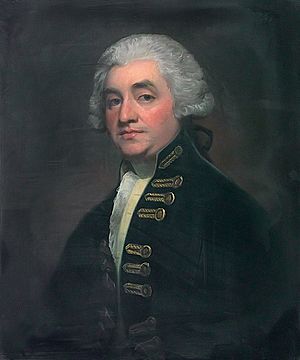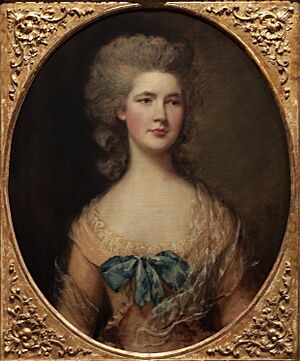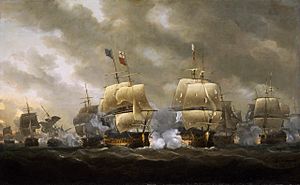Joshua Rowley facts for kids
Quick facts for kids
Sir Joshua Rowley
|
|
|---|---|

Sir Joshua Rowley, Vice-Admiral of the White
|
|
| Born | 1 May 1734 Tendring Hall, Stoke-by-Nayland, Suffolk |
| Died | 26 February 1790 (aged 56) Tendring Hall, Stoke-by-Nayland, Suffolk |
| Allegiance | |
| Service/ |
|
| Years of service | 1744–1783 |
| Rank | Vice-Admiral |
| Commands held | HMS Rye HMS Ambuscade HMS Hampshire HMS Montagu HMS Superb HMS Monarch HMS Suffolk HMS Conqueror Jamaica Station |
| Battles/wars | |
Vice-Admiral Sir Joshua Rowley, 1st Baronet (1734 – 1790) was an important officer in the Royal Navy, which is Britain's navy. He was the fourth son of another famous admiral, Sir William Rowley. Joshua was born on May 1, 1734, in Suffolk, England.
Rowley was known for serving bravely in many battles throughout his career. People at the time thought highly of him. Even though he was often busy in battle, he didn't always get to lead the biggest fights. Because of this, other admirals like Keppel and Hawke became more famous. However, Rowley was still a very strong and reliable commander who helped protect Britain for many years.
Contents
- Early Naval Career and the Battle of Toulon
- Battle of Cartagena: A Key Victory
- Battle of Saint Cast: A Difficult Retreat
- Battle of Quiberon Bay: A Daring Victory
- West Indies and Convoy Duty
- Battle of Ushant: A Controversial Fight
- Battles of Grenada & Guadeloupe
- Rodney and the Battle of Martinique
- Commander-in-Chief Jamaica
- Family Life
- Images for kids
Joshua Rowley joined the navy when he was young. He served on his father's ship, the HMS Stirling Castle. He was part of the Battle of Toulon in 1744. This battle was very confusing and didn't have a clear winner. Because of the confusion, some admirals were removed from the Royal Navy.
After the battle, his father, Admiral William Rowley, became the main commander in the Mediterranean Sea until 1748. Joshua stayed with his father and was promoted to lieutenant on July 2, 1747.
In 1752, Rowley served as a lieutenant on the HMS Penzance, a 44-gun frigate. On December 4, 1753, he was promoted to post-captain. This meant he was now in charge of his own ship, the 24-gun HMS Rye. By March 1755, he was given command of the HMS Ambuscade. This was a 40-gun frigate that the British had captured from the French in 1746.
While on the Ambuscade, Rowley joined a group of ships led by Admiral Edward Hawke in the Bay of Biscay. During this time, Hawke's group captured over 300 enemy merchant ships. By 1756, Rowley had moved to the 50-gun HMS Hampshire.
Battle of Cartagena: A Key Victory

In October 1757, Rowley was given the job of preparing the 60-gun HMS Montague for service. Once ready, his ship joined Admiral Henry Osborn's fleet of 14 ships of the line in the Mediterranean. Osborn's fleet was blocking the French navy in the Spanish city of Cartagena. This stopped the French from joining another fleet in North America.
The French wanted their ships to break through the British blockade. On February 28, 1758, Osborn's fleet met the French ships in what became known as the Battle of Cartagena. Osborn's ships captured two of the French warships. The Montagu and Monarch also forced another French ship, the Oriflamme, onto the shore.
This battle was very important for two reasons. First, it helped the British navy feel proud again after some earlier defeats. Second, it helped the British capture Louisbourg in North America. This made France much less powerful in that region. The Battle of Cartagena was a major success for Britain during the Seven Years' War.
Battle of Saint Cast: A Difficult Retreat
In 1758, Rowley joined Admiral Anson's fleet in the English Channel. He took part in a large British expedition along the coast of France. This mission, in September 1758, involved many ships and over 10,000 soldiers.
The British first captured the port of Cherbourg. They destroyed the port and ships there. However, French troops started to gather. The British then tried to attack Saint-Malo, but it was too well defended. Bad weather also made things difficult.
The British decided to leave from a bay near the village of Saint Cast. The army marched overland while the fleet sailed ahead. On September 11, the French army, with about 8,000 to 9,000 men, attacked the British as they were trying to get onto their ships.
The British retreat was very slow and confusing. The French artillery fired on the beach, causing panic. British ships tried to help, but the French had a strong position. Many British soldiers were killed or captured. Captain Rowley was wounded and taken prisoner on the beach. This battle was a big embarrassment for the British army and navy. It ended Britain's hopes of invading France during the Seven Years' War.
Battle of Quiberon Bay: A Daring Victory
By late October 1759, Rowley was released in a prisoner exchange. This was a common practice where countries swapped captured soldiers. He was back in command of the Montagu. He rejoined Admiral Hawke's fleet.
On November 20, Hawke's fleet attacked French ships in Quiberon Bay. The French had planned to invade Scotland. Quiberon Bay is known for its hidden sandbanks and changing weather. Despite the dangers, Hawke led his fleet directly into the bay.
The British lost two ships, but the French lost six ships and one was captured. Many historians call this battle the "Trafalgar" of the Seven Years' War. It showed how brave and smart Admiral Hawke was. It also showed the confidence his officers had in him. The French were very impressed by the British navy's daring actions and it took them many years to recover.
West Indies and Convoy Duty
In 1760, Rowley went to the West Indies with Commodore Sir James Douglas. He helped in the attack on Dominica. The British landed soldiers and forced the island to surrender on June 7 after just one day of fighting.
In November 1760, Rowley took command of the 74-gun HMS Superb. He escorted a group of East India Company merchant ships that year and then returned to England. In 1762, with two frigates, he protected another group of merchant ships from the French. The East India Company and London merchants were so pleased that they gave him a beautiful silver epergne (a fancy table decoration) and a dish.
During this time, Rowley took a special interest in a young officer named Erasmus Gower. He helped Gower's career, and Gower later became a distinguished admiral.
After some time without a command, Rowley was appointed to the 74-gun HMS Monarch in October 1776. In 1778, he escorted some transport ships to Gibraltar.
Battle of Ushant: A Controversial Fight
When Rowley returned to England, he joined Admiral Keppel's fleet. On July 27, 1778, Rowley led the front part of the fleet in the First Battle of Ushant. His ship, the Monarch, had two sailors killed and nine wounded.
This battle, like Toulon, ended without a clear winner. It caused a lot of trouble and arguments among naval officers and politicians. Admiral Keppel later resigned after a court-martial (a military trial) found him not guilty. Another admiral, Hugh Palliser, was also criticized and resigned from parliament.
Battles of Grenada & Guadeloupe
At the end of 1778, Rowley moved to the 74-gun HMS Suffolk. He was sent to the West Indies with a group of seven ships to help Admiral John Byron. He joined Byron's fleet in February 1779. On March 19, he was promoted to rear-admiral of the blue.
On July 6, 1779, Rowley again led the front part of the fleet against the French Admiral d’Estaing. This battle was a draw and didn't change the course of the war much.
Later that year, Rowley's group of ships captured three French ships: la Fortunée (42 guns), la Blanche (36 guns), and l'Ellis (28 guns). Rowley also led his ships to capture a large group of French merchant ships near Martinique.
Rodney and the Battle of Martinique
When Admiral Sir George Rodney arrived from England to take command, Rowley moved his flag to the 74-gun HMS Conqueror. In this ship, he commanded the rear part of the fleet in the battle off Martinique on April 17, 1780. He also led the front part of the fleet in two more battles on May 15 and 19.
These three battles were also inconclusive, meaning there was no clear winner. When the hurricane season began, the French admiral returned to Europe. Rodney then sent Rowley to Jamaica with ten ships to help protect the colony from a possible Spanish attack.
Commander-in-Chief Jamaica
In 1782, Rowley became the commander of the Jamaica Station. He held this important position until the end of the American War of Independence. Rowley had shown throughout his career that he was brave and a very skilled officer. However, other commanders before him had achieved extraordinary successes in Jamaica, which were hard to match in his short time there.
He also communicated with Henry Christophe of Haiti to try and bring peace to the Kingdom of Haiti. Rowley returned to England in 1783 and did not receive another command. On June 10, 1786, he was given a special honor: he became a Baronet, which is a hereditary title. He was then known as Sir Joshua Rowley, Bt. of Tendring Hall, Suffolk. On September 24, 1787, he was promoted to the rank of Vice-Admiral of the White. He passed away at his home, Tendring Hall in Suffolk, on February 26, 1790.
Family Life

In 1759, Rowley married Sarah Burton, whose father was the Governor of the Bank of England. Even though he was often away at sea, they had a large family:
- Sarah Rowley
- Arabella Rowley
- Sir William Rowley, 2nd Baronet, who later became a Member of Parliament.
- Philadelphia Rowley, who married Admiral Sir Charles Cotton.
- Admiral Bartholomew Samuel Rowley, who also served as Commander-in-Chief of the Jamaica Station.
- Reverend Joshua Rowley
- Admiral Sir Charles Rowley.
Images for kids
| Military offices | ||
|---|---|---|
| Preceded by Peter Parker |
Commander-in-Chief, Jamaica Station 1782–1783 |
Succeeded by James Gambier |
| Baronetage of Great Britain | ||
| New creation | Baronet (of Tendring Hall) 1786–1790 |
Succeeded by William Rowley |




